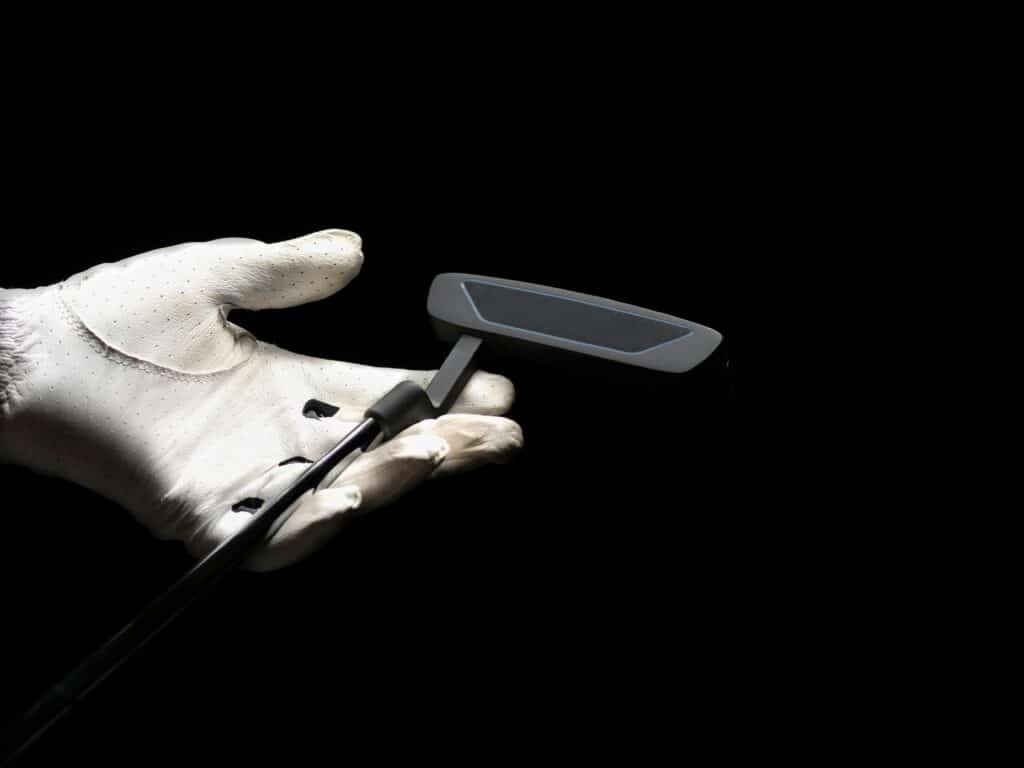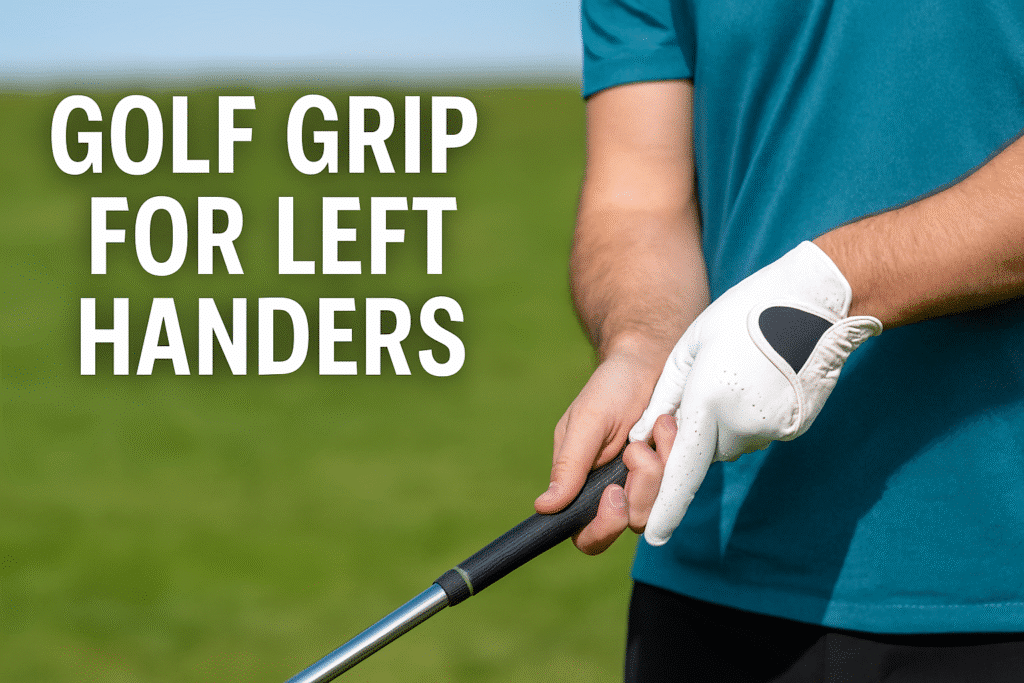A lefty-friendly guide to the golf grip for left handers. Learn easy grip steps, tips for beginners, intermediate and advanced players, plus gear reviews.
Golf Grip for Left Handers: Complete Guidelines for Everyone
Golf is a game of precision, and every player needs a solid grip – lefties included. Left-handed players have unique challenges, from finding gear to mirror-imaging right-handed lessons. In this guide on golf grip for left handers, we cover everything: step-by-step grips for beginners, adjustments for intermediate players, and pro-level techniques. New players will learn how even a simple change in your club hold leads to big improvements – getting comfortable with the golf grip for left handers sets a strong foundation. You’ll also find top gloves, training aids, and clubs reviewed. Let’s tee off and get your left-handed grip dialed in!

Why Grip Matters for Left-Handers
A strong, neutral grip helps every golfer hit straighter, more consistent shots. If your grip is too weak, you’ll struggle with slices (ball curving right for lefties). If it’s too strong, you may hook the ball left. The key is balance. For lefties, get your hands in a neutral position on the club so you can swing freely each time. Lefty pro Phil Mickelson knows this well – he holds the club with a powerful yet relaxed grip, keeping his clubface square to the target.
- Tip: Always check your grip if your shots are veering offline. A neutral grip (midway between weak and strong) usually stops slices and hooks.
How to Grip a Golf Club Left-Handed (Beginner)
Mastering the left-handed grip starts with the right hand (your lead hand). Follow these easy steps:
Place Your Right Hand First
For lefties, your right hand goes on the grip first. Run the club handle diagonally across the base of your right fingers, from the top knuckle of your index finger down toward your pinky. Close your right hand so it feels like a handshake with the club – the grip sits in your fingers, and the thumb pad rests on it. This right-hand lead is the foundation of a proper golf grip for left handers.
Add Your Left Hand
Next, set your left hand (trail hand) below the right on the grip. Again, align the club diagonally across the left fingers. Both thumbs should point down the shaft along the target line. Your left thumb should rest on top of the grip, creating a “V” shape with your left index finger. This V should point to your right shoulder.
Grip Style Choices
Beginners often use the ten-finger (baseball) grip, where all 10 fingers hold the club. This feels natural (like holding a bat) and is great for power. As you improve, try the interlocking grip (hook left pinkie into right index for more control) or the overlapping grip (right pinkie over left index) to make your hands act as one.
Thumb Placement
After both hands are on the club, ensure both thumbs point down the shaft. The Vs formed by your thumbs and index fingers should aim toward your right shoulder – this shows a neutral grip.
Grip Pressure
Hold the club firmly but not too tight. The tension should be enough to control the club without “white knuckles.” A relaxed grip lets your wrists hinge freely for a smooth swing.
Tip: Imagine you’re holding a small bird. Your grip should be gentle, so you don’t crush it, but secure enough so it won’t fly away.
A classic golf illustration showing the swing of a golfer (Chick Evans, 1921). Notice how the hands and club move together – a result of a consistent grip.
Best Golf Grip for Left Handers
There isn’t one single grip that works for all lefties. Most beginners start with the baseball grip (all 10 fingers on the club) because it feels natural. As your game improves, you might switch to interlocking or overlapping grips for more control. Best golf grip for left handers is the one you can hold comfortably while keeping the clubface square at impact.
Grip Styles for Different Levels
Lefties can experiment with grip styles as they improve. Each style has pros:
- Ten-Finger (Beginner): All ten fingers on the club (like a baseball bat). Easy and gives power.
- Interlocking Grip (Intermediate): Lock your left pinkie with your right index finger. Adds stability and control, making the hands work together.
- Overlapping Grip (Advanced): Rest your right pinkie on top of the gap between your left index and middle fingers. Popular with pros for maximum power and consistent shots
As you progress, try different grips on practice swings to see what feels best. For example, start with ten-finger as a beginner and later use overlap for more distance and shot control.
- Tip: Pros often use an overlapping grip for more distance and better placement. As a beginner, focus on any grip that lets you consistently hit the ball.
Beginner to Advanced Grip Techniques
Beginner Methods
Start simple. Use the ten-finger grip and focus on swinging smoothly. Put your hands on the club as above and swing slowly at first. At first, just hitting the ball straight is a win. Keep your right (lead) hand firm and let your left hand provide support. Always hold the club in the fingers (not the palm) – this gives better control.
- Tip: Practice with short chips on the range. It takes the full swing out of it and lets you concentrate on grip. Your golf grip for left handers will improve with every solid contact.
Intermediate Tips
Once you can hit the ball consistently, work on finer points:
- Grip Rotation: Check your right-hand placement. If your right hand’s pad is too far right on the grip, you have a strong grip (will hook). Too far left is a weak grip (slices). Aim for a neutral setup by keeping both V’s aimed around your right shoulder
- Grip Pressure: Many intermediate players grip too tightly. Focus on relaxing your hands a bit. A lighter grip can add speed and improve timing.
- Alignment: Even with a perfect grip, bad posture can ruin a shot. Check your stance and ball position each time. After setting your grip, confirm your feet and shoulders are square to the target.
- Tip: If you still slice or hook, adjust your golf grip for left handers first before changing your swing. Often the problem starts with hand position on the club.
Advanced Techniques
Skilled lefties fine-tune their grip for shot shaping:
- Strong vs Weak Grip: A slightly stronger grip (rotating both hands a bit to the right) can help intentionally draw (left curve) the ball. A slightly weaker grip aids a fade (right-curve). Practice small changes and watch the ball flight.
- Wrist Set and Release: Advanced players use a coordinated wrist roll at impact. This comes from a flexible grip (no tight death grip) and helps close the clubface at the right moment. Top lefties keep their hands working together and let the right hand close the face smoothly.
- Custom Club Grips: Serious golfers sometimes add heavier or tackier grips on their clubs. For example, adding Tour Velvet grips (popular on tour) can give extra traction. A grip that feels secure in your hands helps you release the club naturally.
- Tip: Experiment with small gear changes on the range. For instance, try a stronger grip or a new glove, then hit a few shots. Keeping notes (or video) will show how each change affects your shot.
Equipment for Left-Handed Golfers
Finding left-handed gear can be tricky, but many good options exist:
Left-Handed Gloves
Lefties wear a glove on their right hand. Quality gloves improve feel and prevent slipping. For example:
- Callaway Tour Authentic Glove (Left Hand): Made from premium Cabretta leather, it’s soft and tacky. Callaway notes it has a “20% increase in tackiness” for a secure hold.
- FootJoy WeatherSof (Left Hand): A synthetic leather glove that offers comfort in various weather. Has stretch panels for a great fit.
- Titleist Players Glove (Left): Used by many pros, it features smooth cabretta leather and a classic fit for control.
Check the fit carefully; even a slightly loose glove can spoil your grip. As a reminder: - Tip: Left-handers wear the glove on their right (lead) hand. A snug, well-fitting glove on the right hand ensures your golf grip for left handers stays secure.
- Tip: Always carry a spare glove in your bag. Running out mid-round means playing with bare hands, which can quickly reduce performance.
Grip Training Aids
Special tools can reinforce a proper left-handed grip:
- Retractable Swing Trainers: These have a retractable cord with a handle (like the ProActive Sports Retractable Trainer). They produce a clicking sound and guide your hands through the correct motion. The left-handed model loops around your body to keep tension on the handle.
- Grip Trainer Attachment: SKLZ makes a Grip Trainer that slips onto the club and forces your hands into place. It’s built for right-handers, so many note “I am super disappointed I cannot buy a lefty trainer… hopefully SKLZ will make a lefty version soon!”. (Moral: such aids help but check if a lefty version exists.)
- Instant Feedback Tools: Simple mats or swing boards (like an impact bag or a putting mat) can be used with an oversize grip to ensure your hands move in sync.
- Tip: Use these aids in practice. A few swings with a clicker or grip trainer can program good muscle memory for your actual swing.
Clubs and Grips
Make sure you have lefty clubs from a reputable brand. When buying clubs, check that “LH” (left-handed) is specified. Also consider the grips on your clubs:
Changing grips on your irons or driver for a more comfortable texture can make a subtle difference in control. For lefties, a thicker or softer grip might reduce wrist movement; thinner grips can give more feel.
- Tip: Consider heavier or tackier grips. The right grip on your club reinforces a stable golf grip for left handers. High-traction grips (like corded grips) help in wet conditions.
Notice the clubface orientation – left-handed irons look like mirror images of righty clubs. Choosing the right clubs and grips is crucial for left-handed players.
Top Left-Handed Golf Grip Products (Reviews & Comparison)
We tested and reviewed some popular gear to help lefties improve their grip. Here’s a quick look:
- Achieve a Lighter, Better Grip – Strategically placed patented relief pad system helps even out the surface of your hand…
- Hit Straighter, More Accurate Shots – The double row finger grip system helps you maintain surface contact throughout yo…
- Enjoy Better Range of Motion – Lycra gussets, alongside web and motion zones help enhance flexibility and dexterity.
- 100% Polyester
- Imported
- Poly fabric upper improves fit
- A thinner (but stronger) and softer Cabretta leather (our most expensive Cabretta leather). Best glove anywhere.
- Noticeably lighter with the most sensitive feel in a golf glove.
- Elastic knuckle hinge for a more comfortable grip without tugging.
- 52% Polyester/42% Polyurethane/6% Spandex
- Made in the USA or Imported
- Advanced synthetic leather combined with 4-way stretch lycra
- All-Cabretta Leather
- Quality and traditional styling comparable to FootJoy Sta-Sof
- Winner of several PGA Tour events
- Built for warmth and a secure grip in extreme cold and windy conditions.
- Sold as a Pair
- Microfiber Suede Full Palm – Enhanced Grip in Wet Conditions
- Develop Your Perform in Rain, Hot, Wet Conditions: A Best Choice for Rain Hot Wet Weather Daily Practice. Unbeatable Wet…
- Quality Material to Solve Your Sweat and Moisture Problem: The High Quality 3D Performance Mesh, Provides Perfect Fit an…
- Glove Worn on Left Hand or Right Hand in Size S M ML L XL Available: Please Check the Attached Picture for Hand Orientat…
| Product | Type | Key Features |
|---|---|---|
| Callaway Tour Authentic Glove (Left) | Glove | Premium Cabretta leather, infused with “Griptac” for tackiness. Trusted by pros for fit and durability. |
| FootJoy WeatherSof Glove (Left) | Glove | Synthetic leather, soft feel and water resistance. Comfortable in heat. Stretch panels for perfect fit. |
| ProActive Sports Retractable Trainer (Left) | Swing Trainer | Cable-and-handle trainer with click feedback. Portable design to help you groove your swing. Left-handed model available. |
| Power Grip Trainer (Lefty) | Grip Aid | Rigid plastic aid locking finger placement. Teaches correct top-hand position. Used for practice swings to build grip muscle memory. |
| Golf Pride Tour Velvet Grips | Grips | Standard rubber grips with consistent tackiness. Widely used by pros. Adds secure feel in any weather. |
| Titleist Players Glove (Left) | Glove | Premium cabretta leather glove with classic fit. Known for breathability and durability; a favorite on tour. |
Each of these products helps a left-handed golfer. For gloves, both Callaway and FootJoy are top choices – they fit well and last. Training aids like the Retractable Trainer and Power Grip help lock your hands into a good position and reinforce muscle memory. And high-quality club grips (like Tour Velvet) give any player a consistent hand feel.
- Tip: When comparing gear, focus on left-handed versions. A proper golf grip for left handers starts with the right tools — gloves, grips, and trainers designed for lefties improve consistency.
Other Resources and Tips
Need more lefty golf advice? Many forums and blogs have tips for southpaws. For gear and sustainable golf tips, check out Green Golfing Genius – they cover golf gloves and clubs among other topics.
- Tip: Use a mirror or record your swing to check your form. You should see a solid golf grip for left handers that mirrors the fundamentals.
- Tip: Keep practicing with purpose. Even a great grip takes time to feel natural.
Conclusion
Golf is fun and challenging, but being left-handed shouldn’t hold you back. With the right golf grip for left handers, you can swing confidently from the first tee to the green. Remember the basics: set your hands properly, keep grip pressure steady, and practice with helpful aids. Study lefty pros like Mickelson and Watson for inspiration but find what feels best for you. Your unique left-handed swing can be a strength – it just needs a solid foundation. Keep your hands and club working together in harmony, use the best gear for your style, and have confidence in your shots.
Now get out there, grip it and rip it – and enjoy the game! Focus on the fundamentals each swing, and you’ll develop a reliable golf grip for left handers that builds confidence. And remember, keeping a consistent golf grip for left handers is a skill that pays off on every hole.











